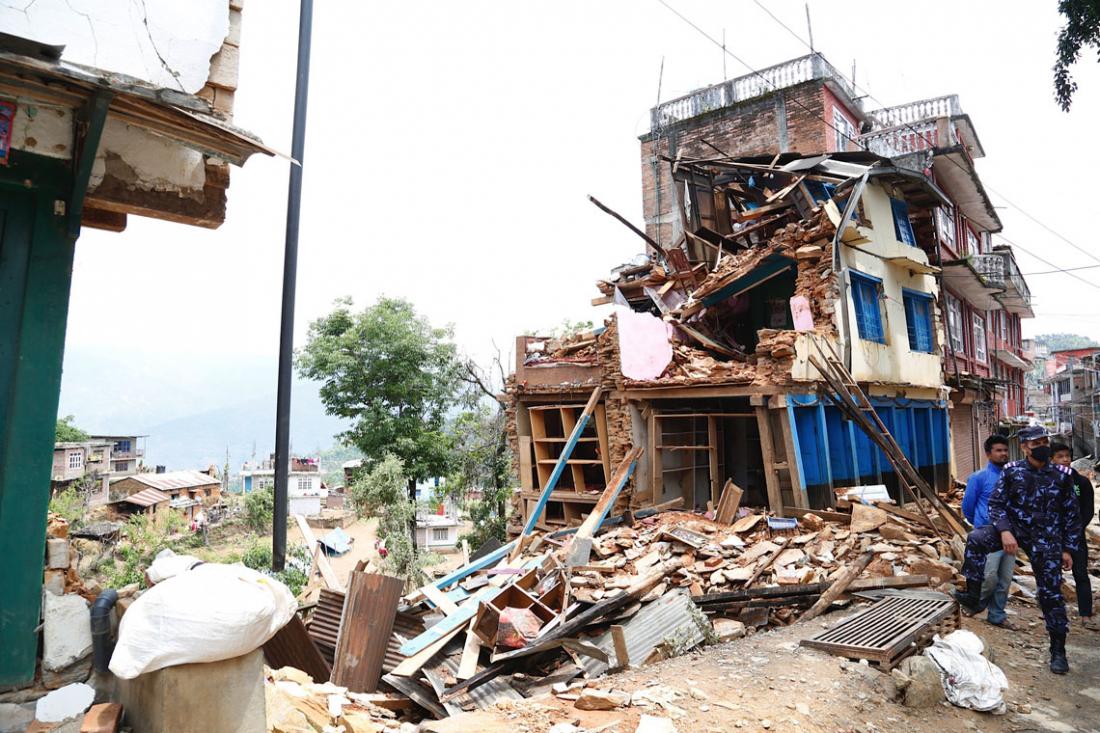Image of collapsed buildings in Chautara, Nepal taken on April 30th after the first earthquake.
Information collected by Science Media Centre Rapid Reaction
IMMEDIATE RELEASE Tuesday 12 May 2015
Expert reaction to second major earthquake in Nepal
---------------------------------------------------------------------------------------------------
Prof Sandy Steacy, Head of School of Physical Sciences at The University of Adelaide, said:
---------------------------------------------------------------------------------------------------
“Although today’s M = 7.3 earthquake could not have been predicted, it is not a wholly unexpected event. The epicentre was just to the east of the rupture plane of the M=7.8 event on 25 April and hence the event was likely triggered by the earlier earthquake. Today's earthquake will have caused additional damage to already weakened structures and is likely to have caused new damage to the east of the areas affected by the April event. Large aftershocks are likely to continue over the next days to weeks and these may cause further damage to buildings as well as landslides and avalanches.”
----------------------------------------------------------------------------------------------------
Dr Carmen Solana, Volcanologist at the University of Portsmouth, said:
----------------------------------------------------------------------------------------------------
"Large earthquakes are often followed by other quakes, sometimes as large as the initial one. This is because the movement produced by the first quake adds extra stress on other faults and destabilise them: it is a chain reaction."
-----------------------------------------------------------------------------------------------------
Dr Richard Teeuw, Principal Lecturer at the University of Portsmouth, said:
-----------------------------------------------------------------------------------------------------
“There is now a major risk of fatalities from associated landslides and - particularly - collapsed of buildings already damaged by the first earthquake. One small positive point: most people in urban areas will probably have abandoned their houses & apartments, fearing damage from after-shocks, before this quake hit. They would be camping in relatively safe open spaces, such as parks and sports grounds: that will have helped to minimise loss of life from collapsing buildings. However, this 2nd major quake adds to the urgent need for shelter; it will probably also lead to more temporary camps having to be established for displaced people. That presents a challenge to the disaster managers who will need to find suitable safe locations for those camps, amidst the mountainous terrain of Nepal - and just before the onset of the monsoon season, which might well lead to further landslides and debris flows.”
----------------------------------------------------------------------------------------------------
Dr Richard Walters, Earthquake Geophysicist at the University of Leeds, said:
----------------------------------------------------------------------------------------------------
“This second earthquake was almost certainly triggered by the stress changes caused by the first earthquake. The epicentre of this second large earthquake occurred at the eastern end of the fault region that slipped during the earthquake on the 25th April. When an earthquake occurs, the area on the fault surrounding the region that ruptured is highly stressed and is brought closer to failure. Therefore the chance of more earthquakes happening in this same region (i.e. aftershocks) is increased. This second earthquake is further to the north than the first and a little deeper, but consistent with rupture on the deeper extension of the same fault as it dips to the north, under the Himalayas.”
----------------------------------------------------------------------------------------------------
Prof David Rothery, Professor of Planetary Geosciences at the Open University, said:
----------------------------------------------------------------------------------------------------
“Today’s magnitude 7.3 earthquake in Nepal (07:05:19 UTC) and the magnitude 6.3 quake that followed at 07:36:53 UTC can be considered as large aftershocks to the magnitude 7.8 quake that struck on 25 April. They were the same kind of shallow event as that (which produces stronger ground-shaking than a deep quake of the same magnitude) and seem to be the result of the original southward-directed underground thrust motion spreading eastwards along the thrust plain.
Today’s quakes were 75 km east of Kathmandu, whereas the 25 April epicentre was an equal distance west of Kathmandu. There may be substantial aftershocks even further east in the coming weeks, but normally we would expect these to become weaker.
“The ground shaking above the epicentre of today’s magnitude 7.3 event was probably about as strong as experienced in the same place on 25 April, but a much smaller area will have been affected.”
----------------------------------------------------------------------------------------------------
Prof Nigel Harris, Professor of Tectonics at the Open University, said:
----------------------------------------------------------------------------------------------------
“Since the first earthquake in April, aftershocks have been migrating more or less southeastwards. There has been a rip in the underlying plate which has suddenly moved west to east and this second earthquake is an extension of that process.
“After the first earthquake, many seismologists said that insufficient energy had been released from that part of the Himalayas and that a further earthquake was possible. Very sadly that's exactly what's happened.
“Some media outlets are reporting that this earthquake is very close to Everest. It is closer than the last one, but is still about 50 miles to the west – so not that close.
“It is worth noting that Kodari is right on the border with Tibet, on a major trade and tourism route between China and Nepal. This earthquake will probably lead to further landslides, blocking that route.”
Declared interests
None declared.
Note to editors
The Science Media Centre is an independent venture working to promote the voices, stories and views from the scientific community to the news media when science is in the headlines. Over 80 supporters including scientific institutions, media groups, charities, universities, corporate organisations and individuals fund the Centre, with donations capped at 5% of the running costs to preserve its independence. This press release contains the personal opinions of those acknowledged, and represents neither the views of the SMC nor any other organisation unless specifically stated.
For more details see our website www.sciencemediacentre.org, please e-mail the Science Media Centre with your comments on our service at [email protected]



